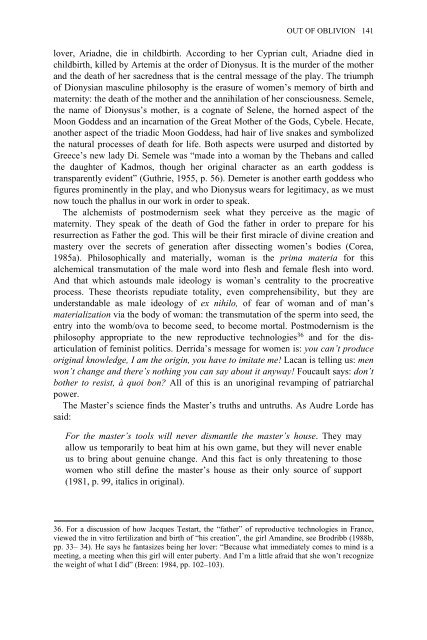Nothing Mat(t)ers: A Feminist Critique of Postmodernism
Nothing Mat(t)ers: A Feminist Critique of Postmodernism
Nothing Mat(t)ers: A Feminist Critique of Postmodernism
Create successful ePaper yourself
Turn your PDF publications into a flip-book with our unique Google optimized e-Paper software.
OUT OF OBLIVION 141<br />
lover, Ariadne, die in childbirth. According to her Cyprian cult, Ariadne died in<br />
childbirth, killed by Artemis at the order <strong>of</strong> Dionysus. It is the murder <strong>of</strong> the mother<br />
and the death <strong>of</strong> her sacredness that is the central message <strong>of</strong> the play. The triumph<br />
<strong>of</strong> Dionysian masculine philosophy is the erasure <strong>of</strong> women’s memory <strong>of</strong> birth and<br />
maternity: the death <strong>of</strong> the mother and the annihilation <strong>of</strong> her consciousness. Semele,<br />
the name <strong>of</strong> Dionysus’s mother, is a cognate <strong>of</strong> Selene, the horned aspect <strong>of</strong> the<br />
Moon Goddess and an incarnation <strong>of</strong> the Great Mother <strong>of</strong> the Gods, Cybele. Hecate,<br />
another aspect <strong>of</strong> the triadic Moon Goddess, had hair <strong>of</strong> live snakes and symbolized<br />
the natural processes <strong>of</strong> death for life. Both aspects were usurped and distorted by<br />
Greece’s new lady Di. Semele was “made into a woman by the Thebans and called<br />
the daughter <strong>of</strong> Kadmos, though her original character as an earth goddess is<br />
transparently evident” (Guthrie, 1955, p. 56). Demeter is another earth goddess who<br />
figures prominently in the play, and who Dionysus wears for legitimacy, as we must<br />
now touch the phallus in our work in order to speak.<br />
The alchemists <strong>of</strong> postmodernism seek what they perceive as the magic <strong>of</strong><br />
maternity. They speak <strong>of</strong> the death <strong>of</strong> God the father in order to prepare for his<br />
resurrection as Father the god. This will be their first miracle <strong>of</strong> divine creation and<br />
mastery over the secrets <strong>of</strong> generation after dissecting women’s bodies (Corea,<br />
1985a). Philosophically and materially, woman is the prima materia for this<br />
alchemical transmutation <strong>of</strong> the male word into flesh and female flesh into word.<br />
And that which astounds male ideology is woman’s centrality to the procreative<br />
process. These theorists repudiate totality, even comprehensibility, but they are<br />
und<strong>ers</strong>tandable as male ideology <strong>of</strong> ex nihilo, <strong>of</strong> fear <strong>of</strong> woman and <strong>of</strong> man’s<br />
materialization via the body <strong>of</strong> woman: the transmutation <strong>of</strong> the sperm into seed, the<br />
entry into the womb/ova to become seed, to become mortal. <strong>Postmodernism</strong> is the<br />
philosophy appropriate to the new reproductive technologies 36 and for the disarticulation<br />
<strong>of</strong> feminist politics. Derrida’s message for women is: you can’t produce<br />
original knowledge, I am the origin, you have to imitate me! Lacan is telling us: men<br />
won’t change and there’s nothing you can say about it anyway! Foucault says: don’t<br />
bother to resist, à quoi bon All <strong>of</strong> this is an unoriginal revamping <strong>of</strong> patriarchal<br />
power.<br />
The Master’s science finds the Master’s truths and untruths. As Audre Lorde has<br />
said:<br />
For the master’s tools will never dismantle the master’s house. They may<br />
allow us temporarily to beat him at his own game, but they will never enable<br />
us to bring about genuine change. And this fact is only threatening to those<br />
women who still define the master’s house as their only source <strong>of</strong> support<br />
(1981, p. 99, italics in original).<br />
36. For a discussion <strong>of</strong> how Jacques Testart, the “father” <strong>of</strong> reproductive technologies in France,<br />
viewed the in vitro fertilization and birth <strong>of</strong> “his creation”, the girl Amandine, see Brodribb (1988b,<br />
pp. 33– 34). He says he fantasizes being her lover: “Because what immediately comes to mind is a<br />
meeting, a meeting when this girl will enter puberty. And I’m a little afraid that she won’t recognize<br />
the weight <strong>of</strong> what I did” (Breen: 1984, pp. 102–103).

















